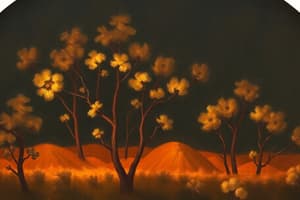Podcast
Questions and Answers
Белсенді тасымалдау молекулаларды клетка мембраналары арқылы шоғырлану градиентіне қарсы жылжытады.
Белсенді тасымалдау молекулаларды клетка мембраналары арқылы шоғырлану градиентіне қарсы жылжытады.
True (A)
Бастапқы белсенді тасымалдау ATP-ны тікелей қолданбайды.
Бастапқы белсенді тасымалдау ATP-ны тікелей қолданбайды.
False (B)
Протондық помпалар сутегі иондарын мембраналарға қарсы тасымалдайды.
Протондық помпалар сутегі иондарын мембраналарға қарсы тасымалдайды.
True (A)
Екіншілік белсенді тасымалдау молекулаларды өз градиентімен бірге жылжытады.
Екіншілік белсенді тасымалдау молекулаларды өз градиентімен бірге жылжытады.
Тасымалдау протеиндері белсенді тасымалдауда маңызды рөл атқармайды.
Тасымалдау протеиндері белсенді тасымалдауда маңызды рөл атқармайды.
Белсенді тасымалдау процессі шектеусіз жылдамдықпен жүзеге асады.
Белсенді тасымалдау процессі шектеусіз жылдамдықпен жүзеге асады.
Сodium-Потасий помпасы белсенді тасымалдаудың мысалы болып табылады.
Сodium-Потасий помпасы белсенді тасымалдаудың мысалы болып табылады.
Белсенді тасымалдау энергиянысыз жүзеге асырылады.
Белсенді тасымалдау энергиянысыз жүзеге асырылады.
Белсенді тасымалдау ATP энергиясын қажет етеді.
Белсенді тасымалдау ATP энергиясын қажет етеді.
Натрий-калий сорғысы жасушадан үш калий ионын шығарады.
Натрий-калий сорғысы жасушадан үш калий ионын шығарады.
Ақуыз пішінінің өзгерісі фосфат молекуласының босатылуымен байланысты.
Ақуыз пішінінің өзгерісі фосфат молекуласының босатылуымен байланысты.
Белсенді тасымалдау концентрация градиентіне қарсы жүреді.
Белсенді тасымалдау концентрация градиентіне қарсы жүреді.
Жасушадан шығатын натрий иондары оң зарядқа ие.
Жасушадан шығатын натрий иондары оң зарядқа ие.
Екі натрий ионын тасымалдау үшін бір калий ионы жұмсалады.
Екі натрий ионын тасымалдау үшін бір калий ионы жұмсалады.
Электрлік градиент жасушаның плазмалық мембранасында пайда болады.
Электрлік градиент жасушаның плазмалық мембранасында пайда болады.
Белсенді тасымалдау жеделдету шектеусіз жылдамдықпен іске аса алады.
Белсенді тасымалдау жеделдету шектеусіз жылдамдықпен іске аса алады.
Уақыт өткен сайын натрий-калий сорғысының тиімділігі артады.
Уақыт өткен сайын натрий-калий сорғысының тиімділігі артады.
Натрий-калий сорғысы ішінара белсенді тасымалдауға жатады.
Натрий-калий сорғысы ішінара белсенді тасымалдауға жатады.
Flashcards
Active Transport
Active Transport
Movement of molecules across cell membranes against their concentration gradient, requiring energy.
Primary Active Transport
Primary Active Transport
Directly uses ATP to move molecules across a membrane.
Sodium-Potassium Pump
Sodium-Potassium Pump
A primary active transport protein that moves sodium out and potassium into the cell.
Secondary Active Transport
Secondary Active Transport
Signup and view all the flashcards
Electrochemical Gradient
Electrochemical Gradient
Signup and view all the flashcards
Transport Proteins
Transport Proteins
Signup and view all the flashcards
Concentration Gradient
Concentration Gradient
Signup and view all the flashcards
ATP
ATP
Signup and view all the flashcards
Active Transport
Active Transport
Signup and view all the flashcards
Sodium-Potassium Pump
Sodium-Potassium Pump
Signup and view all the flashcards
ATP
ATP
Signup and view all the flashcards
Concentration Gradient
Concentration Gradient
Signup and view all the flashcards
Membrane Protein
Membrane Protein
Signup and view all the flashcards
Import of K^+
Import of K^+
Signup and view all the flashcards
Export of Na^+
Export of Na^+
Signup and view all the flashcards
Pump Mechanism
Pump Mechanism
Signup and view all the flashcards
Electrical Gradient
Electrical Gradient
Signup and view all the flashcards
Cellular Process
Cellular Process
Signup and view all the flashcards
Study Notes
Active Transport Overview
- Active transport moves molecules across cell membranes against their concentration gradient.
- This process requires energy, typically in the form of ATP.
- It's vital for maintaining proper ion concentrations and transporting essential molecules into or out of the cell.
Types of Active Transport
-
Primary active transport: Directly uses ATP to move molecules.
- Examples include the sodium-potassium pump and proton pumps.
- In the sodium-potassium pump, ATP hydrolysis changes the protein's shape, moving sodium ions out and potassium ions in against their gradients.
- Proton pumps move hydrogen ions across membranes, creating a proton gradient used for other cellular processes.
-
Secondary active transport: Uses the electrochemical gradient established by primary active transport to move other molecules.
- This occurs when the movement of one substance down its gradient provides energy to move another substance against its gradient.
- For example, in the active transport of glucose into cells, the sodium concentration gradient created by the sodium-potassium pump drives glucose uptake as well.
Mechanisms of Active Transport
- Transport proteins play a crucial role in active transport.
- These proteins, often called pumps, are embedded in the cell membrane.
- They bind to specific molecules, undergo conformational changes in response to energy input, and then release the molecules to the other side of the membrane.
- The process is often regulated.
- Rate of transport can be controlled based on cellular needs. For instance, cells can adjust which proteins are expressed and active based on the transport needed.
Characteristics of Active Transport
- Requires energy: The process needs ATP for its functioning.
- Moves against the gradient: Particles are moved from an area of lower concentration to an area of higher concentration.
- Specific: The pumps are specific for certain molecules.
- Saturable: The rate of transport has limits and can become saturated with transported substances if the number of transport proteins becomes a limiting factor.
Importance of Active Transport
- Maintaining proper ion concentrations: Crucial for nerve impulse transmission and muscle contractions.
- Uptake of essential nutrients: Enables cells to import vital molecules like sugars and amino acids.
Examples
-
Sodium-Potassium Pump: A primary active transport example.
- Transports sodium out and potassium into cells.
-
Proton pumps: Very common in plants and bacteria, involved in pH regulation and maintaining charge gradients.
-
Glucose uptake: Involves secondary active transport, leveraging the sodium gradient to transport glucose.
Regulation of Active Transport
- The cell regulates the processes involved in active transport using various mechanisms, like feedback loops.
- These mechanisms adjust the rate of active transport in response to internal and external conditions, ensuring homeostasis.
Studying That Suits You
Use AI to generate personalized quizzes and flashcards to suit your learning preferences.




